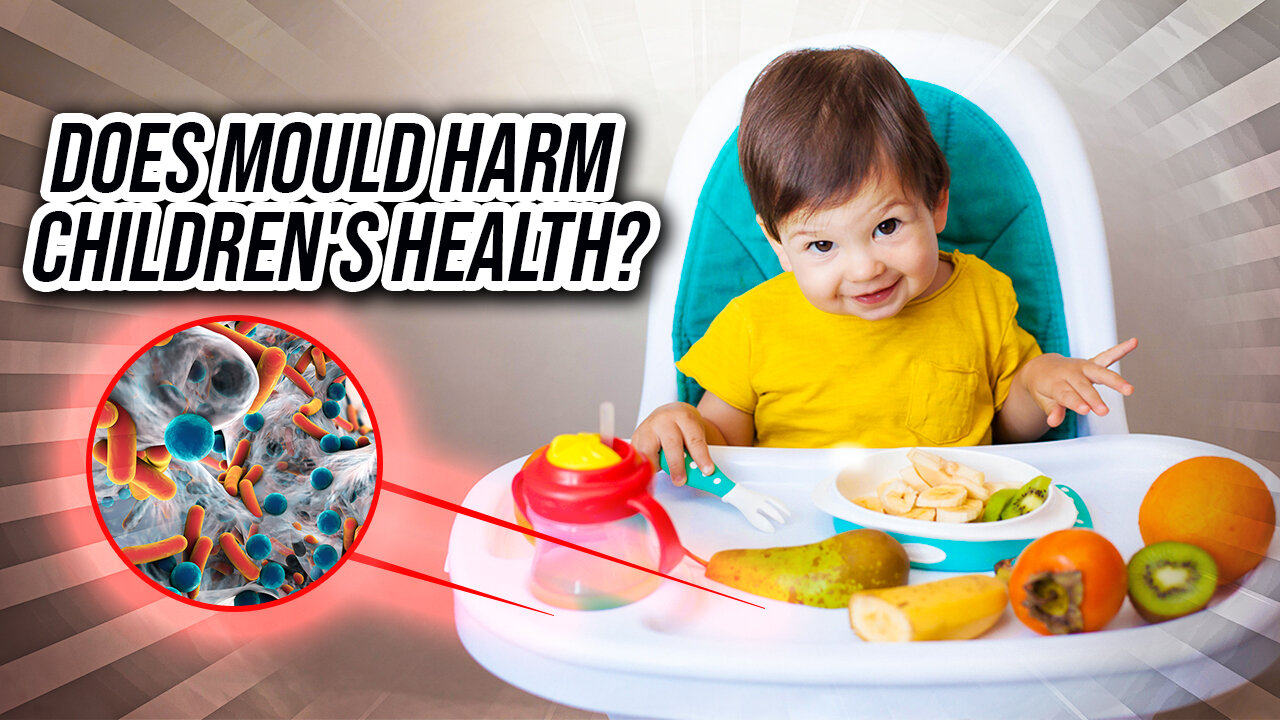Premium Only Content

Does mould harm children's health?
I'm often asked whether mould affects children's health? I thought this would be an appropriate topic to kick off the new year for The Mould Show in 2022. In approaching this topic, I'm going to review some of the key symptoms associated with exposure to mould and then provide you with an easy visual guide that you can use to not only remember the typical mould symptoms, but the causes and effects but that may be helpful when describing indoor air quality issues in your home or workplace.
We all know that unexpected weather increasingly contributes to mould problems indoors in addition to water leaks and home dilapidation problems. In turn, most of us understand that moulds grow on wet surfaces and release their spores into the air. It’s important to remember that mycotoxin levels inside water damaged buildings are sometimes 1000-fold higher than the mould count. It's also known that 50% of fungal growth can be hidden and is missed by mould testing according to the EPA.
To look at the health effects of mould on children, I’ll draw your attention to the first paper The authors review a study from Harvard University looking at 13,369 children aged between 8 and 12 years where they found that mould was growing in up to 50% of the homes and between 3 and 11% of children had asthma.
By comparison, a Russian study showed that for 5951 children having mould in the home and water damage, there was a positive association with symptoms of asthma, dry cough wheezing and bronchitis.
Another important paper in titled The Brain and Mycotoxins by Dr. Andrew Campbell. He talks about how mycotoxins can affect the brain and how research supports a connection with autism spectrum disorder, multiple sclerosis, and dementia and Alzheimer's.
Dr. Campbell stresses the importance of talking with your medical practitioner about blood serum testing for mycotoxin antibodies using the ELISA test. He stresses that urine testing for mycotoxins does not mean the person is suffering from any disease or disorder linked to mould or mycotoxins.
The third paper I want to talk about is examining the impact of mould contamination in early, gestational and postnatal periods. I will be reviewing a paper from Poland that looked at the association between mould exposure and IQ. To do this, we first need to define what the odds ratio is and how this is connected with the confidence interval, which simply means the span where 95% of the observation data points fall on either side of the population mean.
The OR is a way to present the strength of association between risk factors/exposures and outcomes. If the OR is <1, odds are decreased for an outcome; OR >1 means the odds are increased for a given outcome.
OR=1 Exposure does not affect odds of outcome
OR>1 Exposure associated with higher odds of outcome
OR<1 Exposure associated with lower odds of outcome
The Polish research was looking at what the exposure effect for living with mould was on the cognitive development in children. They examined the cognitive function of 277 babies at 6 years of age. A survey was conducted to evaluate the extent of visible mould on indoor walls monitored at different intervals over the postnatal stages after birthing and up to 5 years. This was assessed using the Wechsler Intelligence Scale for children.
They determined that where mould exposure to indoor moulds occurred for greater than two years. children scored significantly lower on the IQ scale with an odds ratio of 3.53 which more than tripled the risk of low IQ scoring.
Put another way:
“The odds of having a lower IQ is 3.4 times higher if the child experienced mould during early life for more than 2 years as opposed to not experiencing mould”.
This paper demonstrates the harmful effects of early pre- and postnatal exposure to indoor moulds on children's cognitive development and emphasizes the importance of the living environment on human cognitive development.
REFERENCES:
Campbell AW, Watson P. Mold, Mycotoxins, and their Effects in Children. Altern Ther Health Med. 2021 Jan;27(1):8-10. PMID: 33609089.
Campbell AW, Decena K. The Brain and Mycotoxins. Altern Ther Health Med. 2020 Nov;26(6):8-11. PMID: 33609092.
Campbell AW. Molds and Mycotoxins: A Brief Review. Altern Ther Health Med. 2016 Jul;22(4):8-11. PMID: 27548484.
Theoharides TC. Mold and Immunity. Clin Ther. 2018 Jun;40(6):882-884. doi: 10.1016/j.clinthera.2018.05.005. Epub 2018 May 30. PMID: 29859636.
Spengler JD, Jaakkola JJ, Parise H, Katsnelson BA, Privalova LI, Kosheleva AA. Housing characteristics and children's respiratory health in the Russian Federation. Am J Public Health. 2004 Apr;94(4):657-62. doi: 10.2105/ajph.94.4.657. PMID: 15054021; PMCID: PMC1448314.
Jedrychowski W, Maugeri U, Perera F, Stigter L, Jankowski J, Butscher M, Mroz E, Flak E, Skarupa A, Sowa A. Cognitive function of 6-year old children exposed to mold-contaminated homes in early postnatal period. Prospective birth cohort study in Poland. Physiol Behav. 2011 Oct 24;104(5):989-95. doi: 10.1016/j.physbeh.2011.06.019. Epub 2011 Jul 8. PMID: 21763705; PMCID: PMC3758954.
Szumilas M. Explaining odds ratios [published correction appears in J Can Acad Child Adolesc Psychiatry. 2015 Winter;24(1):58]. J Can Acad Child Adolesc Psychiatry. 2010;19(3):227-229.
Wong CT, Wais J, Crawford DA. Prenatal exposure to common environmental factors affects brain lipids and increases risk of developing autism spectrum disorders. Eur J Neurosci. 2015 Nov;42(10):2742-60. doi: 10.1111/ejn.13028. Epub 2015 Sep 19. PMID: 26215319.
-
 1:05:28
1:05:28
Flyover Conservatives
22 hours agoUkraine’s Dirty Secret: The Christian Persecution No One Wants to Talk About - Alex Newman | FOC Show
58.5K19 -
 2:00:20
2:00:20
Glenn Greenwald
15 hours agoThe View from Moscow: Key Russian Analyst Aleksandr Dugin on Trump, Ukraine, Russia, and Globalism | SYSTEM UPDATE #414
141K62 -
 1:10:55
1:10:55
Donald Trump Jr.
12 hours agoBREAKING NEWS: My Father Revokes Biden-Maduro Oil License, LIVE with Maria Corina Machado | Triggered Ep.220
203K196 -
 1:25:29
1:25:29
Sarah Westall
11 hours agoX-Files True History, Project Blue Beam, Cabal Faction War w/ Former FBI Agent John DeSouza
84.5K16 -
 7:03:49
7:03:49
Dr Disrespect
18 hours ago🔴LIVE - DR DISRESPECT - NEW PC VS. DELTA FORCE - MAX SETTINGS
170K27 -
 49:04
49:04
Lights, Camera, Barstool
1 day agoIs The Monkey The Worst Movie Of The Year?? + Amazon Gets Bond
78K4 -
 24:19
24:19
Adam Carolla
1 day agoDiddy’s Legal Drama Escalates, Smuggler Caught Hiding WHAT? + Philly Eagles & The White House #news
145K21 -
 10:12
10:12
Mike Rowe
2 days agoClint Hill: What A Man. What A Life. | The Way I Heard It with Mike Rowe
136K17 -
 1:31:52
1:31:52
Redacted News
13 hours agoBOMBSHELL! This is war! FBI whistleblowers reveal Epstein files being destroyed? | Redacted News
204K384 -
 48:55
48:55
Candace Show Podcast
14 hours agoSTOP EVERYTHING. They FINALLY Mentioned ME In The Blake Lively Lawsuit! | Candace Ep 152
175K134